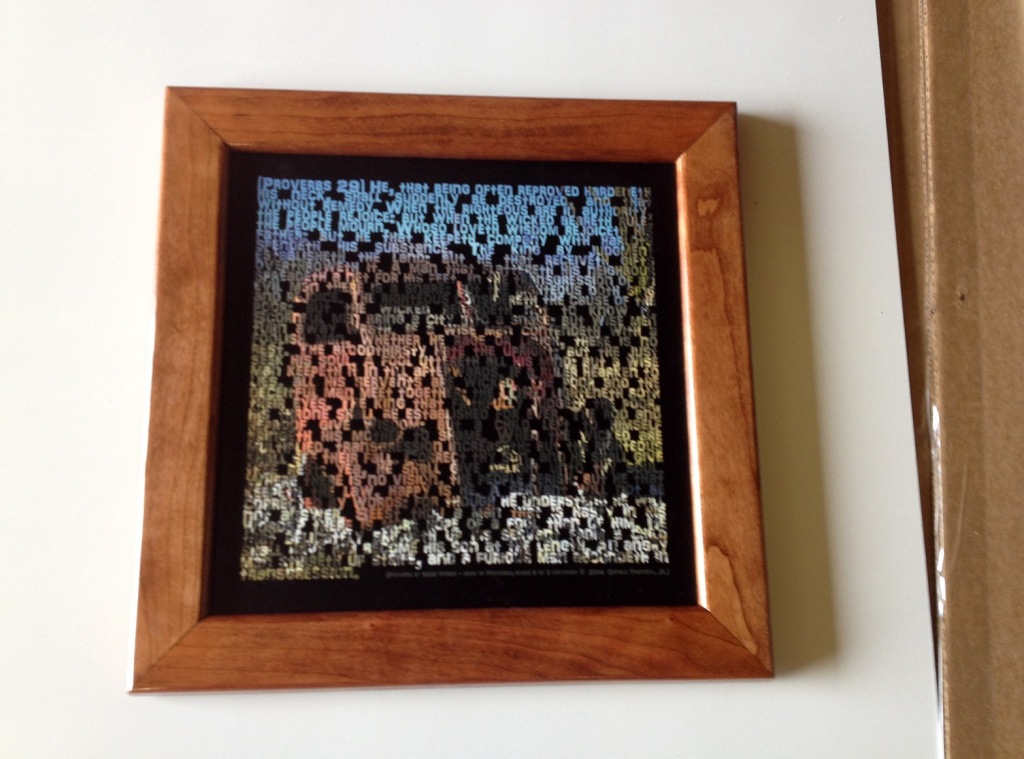Entropic – image 5 from the series Pictures of 1000 Words: Abstractions of Ancient Wisdom

Entropic, along with the other 6 images in the series, has been installed into its official location for ArtPrize 2014 at the First United Methodist Church, at 227 East Fulton Street, Grand Rapids, MI. This photo of it was taken right after it was framed, while it was still in the shop. Thank you, Mr. Lane Elmer 🙂
Entropic is the fifth image in the series entitled “Pictures of 1000 Words: Abstractions of Ancient Wisdom”. It was created using the text from Proverbs 29:1 – Proverbs 9:22.
The subject matter of each image in this series is inspired by some aspect relating to design.
The theme of this fifth image, entitled Entropic, is the deterioration of design. The rusting cab of a truck provides a thought-provoking reminder of what happens when entropy takes its toll on engineered design.
The principles of Design entail the application of intelligence to overcome the natural tendency of order to devolve into chaos. When a design is created and implemented, order is imposed upon the disorder of random chaos. “Entropy” is the amount of disorder or uncertainty in a system. The second law of thermodynamics reflects the observation that systems will equalize when they are not affected by external forces and are left alone. Water flows downhill because it seeks equilibrium. A rock will fall when it is denser than its surroundings. The less friction or resistance to movement there is, the more quickly the slide towards equilibrium will occur.
The effects of this can be seen in many of the static designs that have been developed by human engineers, such as the cab of the truck featured in Entropic. Once the process of imposing order upon one of our “creations” is finished, it immediately begins to slowly fall apart, seeking equilibrium with its surroundings. Rust, wear and tear, and deterioration are all factors that contribute to the order-sapping effects of entropy.
The complex programs of life, which manipulate materials using natural mechanics according to a complex series of strategic instructions encoded into their DNA and RNA, are demonstrations of how intelligent intervention can seemingly add to the order within a system. A running program can do the same thing with data in a computer without the active involvement of a programmer, but the very existence of a program that is exhibiting organizational behavior presumes a prior influx of information from an operator running at a higher magnitude of intelligence. A running program is able to cope with a variety of conditions with a semblance of intelligence because its programmer had the higher intelligence necessary to predict those conditions beforehand, determine methods for coping with them, and encode those relevant solutions into the program before it is run.
Some pseudo-scientists seem to have recently realized the threat posed by the principles of entropy to the viability of their pet bootstrap-theories* that pertain to origins. These theories rely on the level of order increasing within a system without the influx of outside intelligence to explain the existence of the high levels of design we find surrounding us. They are falling over themselves in a panic to patch this “hole” in their “boat” with self-gratifying rhetoric and semi-plausible platitudes, but the fact remains that order will devolve into chaos unless acted upon by either a pre-programmed reaction (as is the case in all instances of life – both plant and animal) or the active influx of information from an outside source of intelligence.
*A bootstrap theory is a theory that, when simplified down to its most basic premise, presents the rough equivalent of a suggestion that a person might be able to raise themselves up by taking hold of their own bootstraps and lifting.